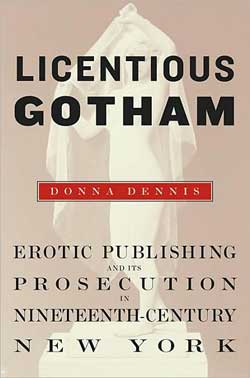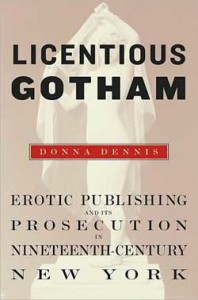Counterproductions

In Licentious Gotham, Donna Dennis provides a seductive view into nineteenth-century New York’s erotica trade, from the gleaming courthouse down into the city’s shadowy depths. Dennis—a professor at Rutgers School of Law-Newark—peels back pseudonyms and unwinds stratagems, moving from newsboys and Nassau Street booksellers along a subterranean network of publishers, printers, and distributors in far-flung warehouses. These are her “protagonists”: producers and sellers of sexually explicit prints who, despite the best efforts of purity crusaders, would not be reformed (11).
Dennis argues that attempts to suppress sexual writing only pushed pornographers toward unintended heights. New York’s first significant wave of obscenity prosecutions—the Whig district attorney James R. Whiting’s 1842 offensive against several racy Democratic “flash press” editors—utterly failed to quash licentiousness in print. Instead, the threat of indictment provoked some calculating participants in the world of underground print to develop a “sweeping, nationwide market for pornography” (6). In an effort to evade local officials, mid-century publishers like George Akarman launched postal schemes that shifted the market from below-the-counter exchanges in seedy shops to mail-order mass distribution.
What began as a protective subterfuge soon spiraled into one of the classic ironies of nineteenth-century America’s sexual history. Whiting’s municipal crusade prompted Akarman and others to “exploit the limitations of federalism”; the new postal cohort in turn “created” Anthony Comstock, the voice of a new and equally cunning generation of anti-obscenity crusaders (273, 9). Comstock’s comic-book-worthy heroics—sting operations as juicy in their details as the prints he sought and destroyed—would produce graver outcomes when he attained unprecedented powers of search and seizure in 1873. Yet for pornographers and their public, Dennis’s story ends almost happily.
Over the century the shape of erotica shifted: from “flash weeklies” to “fancy books” to “more ephemeral commodities” like photographs and playing cards in an era of heightened risk (280). A few brilliant technological appropriations (e.g., the stylograph) also aided licentious publishers in circumventing each new law. But at no point were the presses still.
Some readers may wonder whether Dennis is a little too blithe about the dangers of “Comstockery.” But many others will thank her for shifting our focus from the censors to their infinitely more interesting nemeses. Her cast of characters may frustrate libertarians as much as they irked moral reformers, since obscenity defendants almost never fought their indictments on lofty First Amendment principles. Most preferred to plead guilty, jump bail, bribe officials, and slip through loopholes—all the while learning how to better lubricate their future operations. Yet given the continued efflorescence of erotic writing, people like George Akarman and his more prolific contemporary, William Haines, should be acknowledged as equally influential in the culture at large. And besides, who doesn’t want to know more about The Secret Habits of the Female Sex?
Licentious Gotham tells all sorts of new stories, contributing in the process to a promising historiographical trend that foregrounds sexual dissent and “conversation” even amidst vigorous efforts to achieve conformity and control. The main tale is a cautionary one, although it turns not on the dire consequences of legislating morality but instead on the futility of such attempts. Actually, “counter-productive” may more accurately describe nineteenth-century anti-obscenity prosecutions than “futile,” since as Dennis so artfully shows, they impelled behaviors—and even desires—completely counter to moralists’ intentions.
Here the book especially shines for its subtle, archive-driven application of key theories. The wave of complaints that too many references to Foucault and Butler take all the fun out of studying sex has crested at such a height that it almost threatens to take all the fun out of reviewing books about sex. All that needs to be said on this score is that Licentious Gotham kills no joy. Its stories—sparkling with details gathered from exhaustive, original research—just breathe incitement.
Dennis carefully avoids caricaturing reformers as the bumbling neurotics and shrewd hypocrites we might find in a T. C. Boyle novel; she portrays Comstock as ingenious as he was earnest. But throughout the book she relies on what has become a piece of too-tidy shorthand—“bourgeois respectability”—to describe the ethos of sexual restraint and female passionlessness that the erotic publishers resisted. Meanwhile, her evidence paints a far more intriguing picture. While editors of the 1840s flash press catered explicitly to laboring male Democrats, the following decade saw middle-class consumers paying two or more dollars per cloth-bound “fancy book” (some now illustrated by an ardent Whig lithographer named Henry R. Robinson).
One of the most amazing contributions of Licentious Gotham is the clear view it offers into the forbidden fantasies that defined the obscene. Dennis unearths this content by reading indictments for obscenity in New York’s Court of General Sessions, which include some of the only surviving excerpts of books that were destroyed in anti-obscenity campaigns. We know that Europeans devoured gamey tales of flagellation, fetishes, and orgies. So what was the single most widespread fantasy circulated by New York publishers and loathed by national censors? The idea that women—married women no less—desired, pursued, and enjoyed sex.
Axiomatically, “female purity” rated highest among the criteria of “bourgeois respectability.” Yet New Yorkers across the class continuum apparently shared a love for reading narratives by men writing as voracious women. Had “middle-class standards” of sexuality really gelled? And did representations of passionate women necessarily imply a critique of the bourgeoisie?
Rich depictions of what Dennis generously calls “female erotic subjectivity” (100)—women-on-top scenarios, sex between women, and voyeuristic onanistas—raise other questions. What did it mean to fetishize women’s sexual agency? Historians such as Clare Lyons, Patricia Cline Cohen, Helen Horowitz, and Timothy Gilfoyle have argued that representations of female pleasure often coexisted in the vernacular and sporting male sexual cultures with violence against women who behaved as “autonomous subjects” (176).
Dennis makes an especially interesting case by suggesting that substantial numbers of women may have read the most explicitly pro-female-passion periodical of the century, Venus’ Miscellany. But the images of desirous women in this journal were embedded in George Akarman’s advice to women—framed as that of a female narrator—to cultivate the art of “pleasurism” in order to keep their husbands interested. Could female sexuality have been disciplined even when women participated in a forbidden medium? Celebrating companionate marriages, even sexually adventurous ones, could constrain while appearing to liberate. Women who thrilled to discover the lusty Maria’s “lesbian affair” with a neighbor might have heard the other shoe drop when they read that Maria’s husband soon got in on the action (178).
Overall, Licentious Gotham convincingly demonstrates the ways in which obscenity regulations backfired by creating “the conditions for new forms of sexual titillation” (7). Besides being a fabulous read, it is a handy antidote to the hard-dying stereotype of the nineteenth century as a dismal reign of prudery. But its importance transcends the history of sexuality by disturbing old claims about middle-class hegemony and the nature of state power.
This article originally appeared in issue 9.4.5 (September, 2009).
April Rose Haynes is currently an NEH fellow at the Massachusetts Historical Society, where she is revising her dissertation, “Riotous Flesh: Gender, Physiology, and the Solitary Vice, 1830-1860” (UC Santa Barbara, 2009) for publication. She will spend the coming academic year at the American Antiquarian Society as the Hench Post-Dissertation Fellow.
